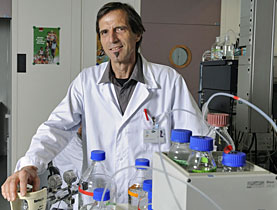Gene doping in sport: fact or fiction?

Experts believe it is only a matter of time before athletes manipulate their genetic material to gain an unfair advantage despite the current lack of proven cases.
A science journalist, who has published a novel on the theme, and a scientist working in the field of genetics talked to swissinfo about the likelihood and dangers of gene doping in sport.
Since the times of ancient Greece, a minority of athletes have employed a variety of potions to artificially boost their performance. More recently, amphetamines, anabolic steroids and hormones have been the drugs of choice.
The World Anti-Doping Agency (WADA) has recently turned its attention to the threat of gene doping and officially banned the practice in 2003. There have already been suspicions of some athletes using the gene therapy Repoxygen to increase their red blood cell count and thereby allow the body to absorb more oxygen.
Professor Max Gassmann of Zurich University’s Institute of Veterinary Physiology has manipulated the erythropoietin (EPO) gene of mice to produce more oxygen carrying red blood cells – a process that could eventually be transferred to humans.
Gassmann does not think gene doping has infiltrated sport at the moment but believes some people may already be testing its potential, just as beneficial gene therapy is currently undergoing clinical trials.
“I can hardly imagine that we had a gene doping cheat winning at the Beijing Olympics,” he told swissinfo. “But there has been doping throughout history and if gene doping becomes viable then you cannot stop it, because people want to win.”
Fictional leap
Author Beat Glogger has taken the theory a stage further by writing a thriller – “Run For My Life” – about genetically modified athletes. Glogger, also a science journalist, and Gassmann contributed to a Swiss sports ministry document warning about the risks of gene doping.
Scientists have already identified more than 150 genes that potentially influence performance in sports. These include genes that control muscle growth, muscle speed and the production of red blood cells.
“I take the next step into fiction by saying it is possible to manipulate the genes that control speed, power, endurance and even mental strength. These are the four key factors for athletic performance,” Glogger told swissinfo.
There are many cases of people with naturally malfunctioning genes. Most of the time this results in health problems, such as muscular dystrophy, but the rare occurrence of a mutation can also bring benefits.
Finnish cross-country skiing legend Eero Mäntyranta won race after race in the 1960s because of a natural genetic mutation that helped his blood absorb large amounts of oxygen. It would be very hard in future to determine if such a case was caused by nature or gene manipulation, according to Glogger.
“If, after the introduction of the relevant genes, the body produces more EPO or testosterone by itself then you cannot detect it – it looks like you are a natural,” he said.
To die for
However, athletes run a high risk of developing serious diseases such as cancer or even dying if they submit to gene manipulation that is still in the early days of scientific development.
Gassmann’s genetically modified mice live only half as long as other mice. Scientists know how to modify genes and introduce them into the body, but not how to control the behaviour of such genes once they have been implanted.
“Whatever you put into the body is hard to control. If you realise it is no good then it is almost impossible to stop, and that is what could happen with gene cheating athletes,” Gassmann said. “It is easy to switch on a light but much more complicated to dim it.”
One method of controlling modified genes is to develop drugs that act like on and off switches, but this process is still in its infancy.
“Gene doping could be undetectable and it could improve performance but you could also die,” Glogger warned. Just like the characters in his book.
swissinfo, Matthew Allen in Zurich
The fledgling medical science of gene therapy has already produced some breakthrough results, but still has some way to go before it is perfected. It involves the insertion of genes into the patient’s cells and tissues.
Scientists hope the treatment can one day become a standard cure for patients suffering from such conditions as immune deficiency and muscular dystrophy.
One method of introducing healthy genes into the body is by injecting manipulated viruses that “infect” cells with the properly functioning genes rather than their own harmful genetic material.
Another method is to extract cells from the patient’s body, insert the gene and then put the cells back. White blood cells or bone marrow cells are commonly used in this technique.
It is also theoretically possible to insert healthy genes into the sperm or eggs of patients with genetically transmitted conditions. However, this practice has been banned in many countries on ethical grounds.
The next big step in gene therapy is the discovery of how to control the activity of genes once they have been introduced into the body. Scientists are working on drugs that could switch the genes on and off.

In compliance with the JTI standards
More: SWI swissinfo.ch certified by the Journalism Trust Initiative












You can find an overview of ongoing debates with our journalists here . Please join us!
If you want to start a conversation about a topic raised in this article or want to report factual errors, email us at english@swissinfo.ch.